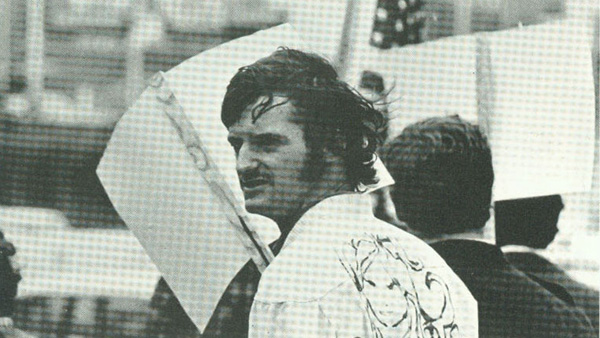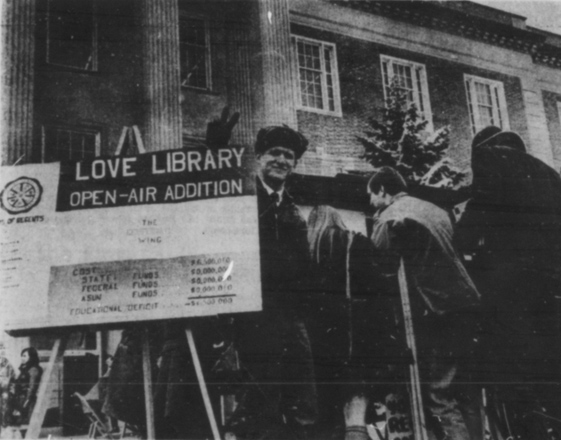
The sounds of clubs meeting skulls, of tear gas induced screams, or gunshots in the air never echoed through the University of Nebraska campus, but the lack of violent repression does not mean there was no protest. Student groups at the University organized a wide array of demonstrations throughout the school year concerning an array of issues and saw varying degrees of participation. However, students did participate; action was taken though it may not have been successful in each case. April 1969: On the north lawn of Love Library, students and faculty attended a sit-in discussion of educational reforms. Among the discussion was the elimination of academic credit for ROTC, elimination of faculty status for ROTC instructors, the addition of courses focused on world cultures and political involvement, and a new grading system based on a fail, pass, pass with honors idea ("Biafra, ROTC..."). April 18, 1969: On the last day of a three-day protest for 20 concerns to be addressed, the Afro-American Collegiate Society (A-ACS), headed by Wayne Williams, lead a peaceful march to the administration and a sit-in on the first floor as Wayne Williams and other A-ACS members met with Administrators and worked through a list of 20 concerns. Williams said, "We're not asking for miracles, we realize that time is needed...but we just want to see some concrete progress. If students come back to school...and see that proposals have not been developed...this campus is going to blow up" ("Black students, administration..."). December 1968: The Human Rights Committee (HRC) organized a talk-in about the "true color" (white) of Lincoln. Panels of "experts" (City Human Rights Commission, local poverty program, etc.) and "radical troublemakers" (Dan Looker, Jack Todd, Mike Shonsey, etc.) would speak and answer questions about poverty and whitewashed prejudice in the Lincoln area. The talk-ins took place in Selleck, Cather-Pound, Abel-Sandoz, and Harper-Schramm-Smith ("Lincoln...its true..."). September 1968: Campus construction threatened the "grassy haven" between Architecture Hall, Sheldon Art Gallery, and the Music Building causing architecture, art, and music students to take action. Before the Saturday football game the concerned students put up an easel explaining the campus' attempt to "rape" the last shaded grassy areas. The students asked passers-by to sign a petition opposing tree removal and said if it failed they would make human rings around the trees to protect them ("Leaf our..."). November 1968: Music students started a petition asking that library materials related to music be transferred from Love Library to the Westbrooke Music Building (Eckholt, Nov. 18). 
September 1968: As a memorial to the Nebraska American Independent Party Convention of 1967 which touched off two nights of unrest in Omaha, students planned a candlelight protest for the "slain freedom fighters" ("Protest planned wit..."). December 1968: At the Nebraska-Wichita basketball game, Students for a Democratic Society (SDS) protested against military recruiting on campus, granting of academic credit to ROTC programs, and the war in Vietnam. The protesters formed a mock military to "graphically reflect the absurdity of the military organization in a campus community that is supposedly dedicated to the principles of academic freedom" (DN, Dec. 9, 1968) donning orange helmets and sandwich boards as they yelled "Sieg Heil" and passed out leaflets that read: "See Joe. See GI Joe. See GI Joe study...He kills very well. Kill. Kill. Kill. Joe loves to kill for freedom. So he kills slaves. He would like to kill Peace and Freedom marchers...Joe hates this primer. Hate. Hate. Hate. He will tear it up. Kill. Kill. Kill" (DN, Dec. 20, 1968). March 1969: Protesters constructed a 4x12 foot cardboard shack named the "Centennial Wing" in front of Love Library to protest the Library's shortage of books and study space ("NU students shack..."). Stationary was passed out so protesters could write their state senator to ask for money for a new library while 400 signatures were collected, literature was handed out, and signs read "We need more LOVE" ("Shortage of..."). April 1969: On April 16, 17, and 18 of 1969, the Afro-American Collegiate Society (A-ACS), headed by Wayne Williams, peacefully protested in front of the Administration building asking that 20 concerns be addressed. On Tuesday, 70 people stood near the Administration building clapping and chanting "Action! Action!" and "Black power." A wall of bricks was symbolically constructed blocking a sidewalk and the protest was said to be "the result of the Administration's inability to implement relevant programs for minority groups in general and Black students specifically" ("NU students protest administration's..."). On Wednesday, 55-70 demonstrators marched around the Administration building carrying bricks to symbolize power. A cardboard coffin labeled "the system" was burned as some chanted "the system is dead, burn baby, burn." Demonstrators called for a Black counselor and coordinator as well as more financial aid for minority groups and a request to meet with the Board of Regents ("Black students find..."). October 3, 1968: To oppose the "hidden discrimination" in Lincoln, students marched to City Hall. Originally, demonstrators were going to march to Adolph Hock's house, the man who denied an apartment to Mr. and Mrs. McGhee because they were black, but due to his poor health the organizers changed to City Hall. Organizers called for an orderly procession, as a disorderly one "would only make Lincolnites angry" ("March to city hall to..."). Dan Looker, Chairman of the Human Rights Committee said "We are here to dramatize the injustice that exists in some of Lincoln's housing and to show student support for a city ordinance concerning open housing," and in front of City Hall demonstrators signed petitions, called for Mayor Schwartzkopf to appear and speak, and the City Human Rights Commission answered any questions ("ASUN committee schedules..."). The protest attracted few onlookers and when one asked, "What are they against?" another inaccurately replied, "They're against anyone who has money." ("Five hundred students..."). | |||||
| |||||
